Aerospace & Defence

EFAS - Environmentally Friendly Airport ATM Systems
The National Air Traffic Services (NATS) has forecast that UK air traffic will increase by 45% by 2015. This is expected to have a major environmental impact at and around airports. Environmental impacts such as noise and engine emissions, if not addressed, will lead to unsustainable growth and constrain the development of airports.
The EFAS project (Environmentally Friendly Airport ATM Systems) aims to address this challenge. It was selected for joint industry/government funding by the Department of Trade and Industry (now known as the Technology Strategy Board).
Objectives of EFAS
- To identify candidate ATM technologies and systems that will reduce the environmental impact of growth in air traffic
- To evaluate the effectiveness of the selected candidate solutions, using an Airport Synthetic Environment simulation tool
- To select the best candidate solutions for large scale validation in the later projects within the longer term ATM Technology Validation Programmes
- To focus on solutions that can be implemented through ATM improvements
- A number of scenarios were developed for each candidate ATM technology to be simulated using the Synthetic Environment.
Scope
The scope for the technical solutions covered by EFAS were defined as follows:
- Consider noise and key engine emissions ( NOx, CO)
- Technology timescale: up to 2030
- TMA airspace, airport (runway, taxiway)
- Focus on larger airports where the environmental challenge is more acute
- Address only environmental impact from aviation
- Envisage step changes in technology
- Civil aircraft but not military
- IFR traffic but not VFR

Figure 1: The above image illustrates the type of noise contour display produced by the AVRRC.
Research Activities
The AVRRC at Loughborough University led three key work packages:
1. Systems Engineering Approach to Consolidated System Design: To determine applicable synthetic environment methodologies and recommend the effective use of the synthetic environment
2. Support to Modelling:
a) To provide deep track research/support to the synthetic environment and modelling process.
b) To provide recommendations on optimal user interaction and visualization with pre and post synthetic environment execution.
c) To provide appropriate means to allow post simulation data to be manipulated by project partners
3. EFAS Route Builder Software, developed by the AVRRC
a) Assessment Planning & Guidance: Prepare guidance to participants to ensure a consistent approach to appraisal and comparability of results from the Synthetic Environment
b) Lead the development of criteria for prioritisation/appraisal. For example, likely candidates are emissions, economic viability, capacity, safety etc.
c) Altitude and air speed an arrival aircraft plotted against distance from touchdown

Figure 2: Large immersive interactive display used for interpretting EFAS data displays
Research Outputs
A suite of research outputs were produced by the project. The majority of these are company confidential to the project partners.
- A set of tested system engineering methodologies to support construction and exploitation of distributed Synthetic Environments for non modelling experts
- An integrated suite of software tools to support scenario definition, processing, visualisation and analysis. Such tools focussed upon:
- Innovative visualisation solutions to support construction of scenarios and analysis of the Synthetic Environment outputs
- Ensuring maximum accessibility for the Synthetic Environment by providing a scenario construction environment usable by non-modelling experts
- The EFAS Scenario Builder Tool, Web Based Software developed by the AVRRC
- A set of recommendations for optimal use and visualisation of Synthetic Environment results
Project Consortium
Led by Thales, the EFAS consortium also included SELEX-SI, QinetiQ, NATS, BAE Systems,. Helios Technology Ltd, the Manchester Metropolitan University (Centre for Air Transport and the Environment - CATE) and the Loughborough University (Advanced VR Research Centre - Research School of Systems Engineering). Cranfield University (Department of Air transport) also supporting the project.
EFAS was launched on 17 January 2006, and run until successful completion in 2008.
For further details please contact Professor Roy S. Kalawsky
email: r.s.kalawsky@lboro.ac.uk (tel: +441509 635678)
